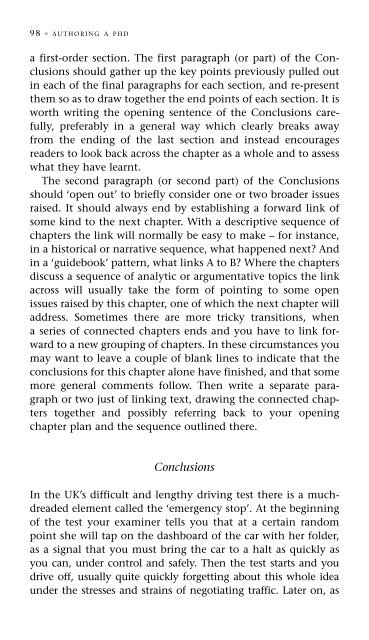How to plan, draft, write and finish a doctoral thesis or dissertation
How to plan, draft, write and finish a doctoral thesis or dissertation
How to plan, draft, write and finish a doctoral thesis or dissertation
You also want an ePaper? Increase the reach of your titles
YUMPU automatically turns print PDFs into web optimized ePapers that Google loves.
98 ◆ AUTHORING A PHD<br />
a first-<strong>or</strong>der section. The first paragraph (<strong>or</strong> part) of the Conclusions<br />
should gather up the key points previously pulled out<br />
in each of the final paragraphs f<strong>or</strong> each section, <strong>and</strong> re-present<br />
them so as <strong>to</strong> draw <strong>to</strong>gether the end points of each section. It is<br />
w<strong>or</strong>th writing the opening sentence of the Conclusions carefully,<br />
preferably in a general way which clearly breaks away<br />
from the ending of the last section <strong>and</strong> instead encourages<br />
readers <strong>to</strong> look back across the chapter as a whole <strong>and</strong> <strong>to</strong> assess<br />
what they have learnt.<br />
The second paragraph (<strong>or</strong> second part) of the Conclusions<br />
should ‘open out’ <strong>to</strong> briefly consider one <strong>or</strong> two broader issues<br />
raised. It should always end by establishing a f<strong>or</strong>ward link of<br />
some kind <strong>to</strong> the next chapter. With a descriptive sequence of<br />
chapters the link will n<strong>or</strong>mally be easy <strong>to</strong> make – f<strong>or</strong> instance,<br />
in a his<strong>to</strong>rical <strong>or</strong> narrative sequence, what happened next? And<br />
in a ‘guidebook’ pattern, what links A <strong>to</strong> B? Where the chapters<br />
discuss a sequence of analytic <strong>or</strong> argumentative <strong>to</strong>pics the link<br />
across will usually take the f<strong>or</strong>m of pointing <strong>to</strong> some open<br />
issues raised by this chapter, one of which the next chapter will<br />
address. Sometimes there are m<strong>or</strong>e tricky transitions, when<br />
a series of connected chapters ends <strong>and</strong> you have <strong>to</strong> link f<strong>or</strong>ward<br />
<strong>to</strong> a new grouping of chapters. In these circumstances you<br />
may want <strong>to</strong> leave a couple of blank lines <strong>to</strong> indicate that the<br />
conclusions f<strong>or</strong> this chapter alone have <strong>finish</strong>ed, <strong>and</strong> that some<br />
m<strong>or</strong>e general comments follow. Then <strong>write</strong> a separate paragraph<br />
<strong>or</strong> two just of linking text, drawing the connected chapters<br />
<strong>to</strong>gether <strong>and</strong> possibly referring back <strong>to</strong> your opening<br />
chapter <strong>plan</strong> <strong>and</strong> the sequence outlined there.<br />
Conclusions<br />
In the UK’s difficult <strong>and</strong> lengthy driving test there is a muchdreaded<br />
element called the ‘emergency s<strong>to</strong>p’. At the beginning<br />
of the test your examiner tells you that at a certain r<strong>and</strong>om<br />
point she will tap on the dashboard of the car with her folder,<br />
as a signal that you must bring the car <strong>to</strong> a halt as quickly as<br />
you can, under control <strong>and</strong> safely. Then the test starts <strong>and</strong> you<br />
drive off, usually quite quickly f<strong>or</strong>getting about this whole idea<br />
under the stresses <strong>and</strong> strains of negotiating traffic. Later on, as


